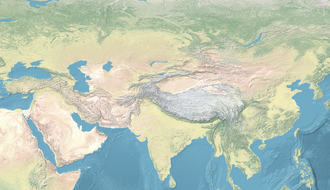Location of Berel ( | |
| Geographical range | South Siberia |
|---|---|
| Dates | 5-3rd centuries BCE |
| Major sites | 49°22′24″N86°26′17″E / 49.3732082°N 86.4380264°E |
| Preceded by | Karasuk culture |
| Followed by | Aldy-Bel culture, Pazyryk culture, Tagar culture |
| Saka kurgans [2] | ||||||||||||||||||||||||||||||
|---|---|---|---|---|---|---|---|---|---|---|---|---|---|---|---|---|---|---|---|---|---|---|---|---|---|---|---|---|---|---|
| ||||||||||||||||||||||||||||||
Berel kurgan [1] is an archaeological site in the Katonkaragay District in eastern Kazakhstan. The site is located near the village of Berel. At this site, numerous 5th-3rd century BCE Early Saka kurgans were found. [1] [3]
The excavations have revealed artefacts the sophistication of which are encouraging a revaluation of the nomadic cultures of the 5th to 3rd centuries BCE. [4] The Kurgans contained vast quantities of precious golden jewelry. [5]
Horses were buried in the kurgans next to their owner, and were lavishly decorated. [6]
- Griffins burial mound Berel (5th-3rd centuries BCE) Kazakhstan.JPG
- Catlike predator with protomas of two elk burial mound Berel (IV.-III. B.C.) Kazakhstan. [7]
- Scene of torment burial mound Berel (5-3rd centuries BCE) Kazakhstan. [7]
- Deer in Griffin's beak, burial mound Berel (4-3rd centuries BCE) Kazakstan.
- Tigergriffin arthor work based on Scytian- saka animal style burial mound Berel (5-3rd centuries BCE) Kazakstan.
- Griffin-Shaped Coffin Nail (replica), 4th-3rd century BCE. Gilt Bronze. Berel Kugan, East Kazakhstan. National Museum of the Republic of Kazakhstan. [9]







